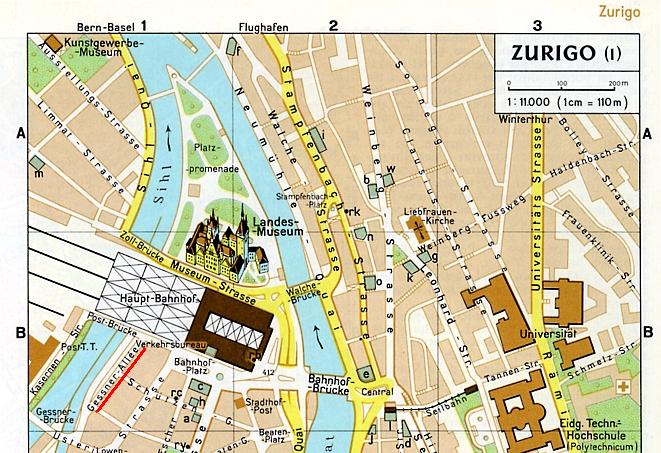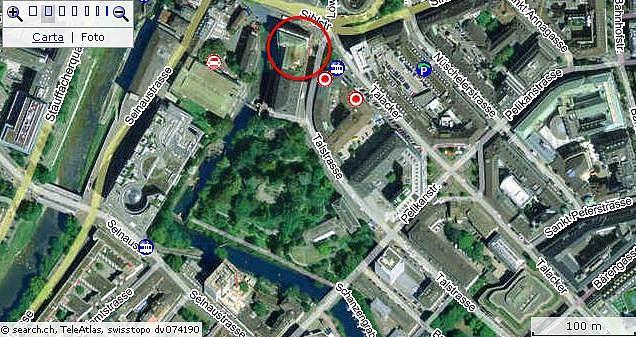Why a Geßner Zentrum?
Nobody is a prophet in his homeland!
Ὁ δὲ Ἰησοῦς εἶπεν αὐτοῖς, Οὐκ ἔστιν προφήτης ἄτιμος εἰ μὴ ἐν τῇ πατρίδι καὶ ἐν τῇ οἰκίᾳ αὐτοῦ.
Iesus autem dixit eis: Non est propheta sine honore nisi in patria sua et in domo sua.
But Jesus said them: A prophet is not devoid of honor unless in his homeland and home.
Mattew 13,57
The proverbs, also those inherited from Gospel, look like SMS messages so in fashion today, however they have the peculiarity of holding millennia of human knowledge.
The
statement of Jesus – who dying in his homeland showed the faithfulness of
his aphorism – is perfectly fitting also in Gessner's case. In Zurich,
native town of Conrad, there is a street entitled to one Gessner, the Gessnerallee,
but after a frantic search - successfully carried out by Francesca Marchisio![]() -
we got to the end of a mystery which left us quite astounded.
-
we got to the end of a mystery which left us quite astounded.

The
Zurich's Gessnerallee is not entitled to Conrad but to the painter
Salomon Gessner![]() .
The fact is that they neither entitled a lane to Conrad - just imagine a
museum! - nor pulled francs from their pocket for devoting to him I don't say
a colossus, but a small bas-relief:
.
The fact is that they neither entitled a lane to Conrad - just imagine a
museum! - nor pulled francs from their pocket for devoting to him I don't say
a colossus, but a small bas-relief:
"Heute 29. Maj 2006 habe ich an die Zürich Polizei (0041-44-4117117) angerufen um Information über Gessnerallee zu haben; die Polizistin hat mir gesagt daß diese Straße ist an Salomon Gessner gewidmet der war ein Maler, und in aller Stadt Zürich gibt es keine Straße oder Monument oder Museum an unserer Arzt Conrad Gessner gewidmet."
Quite the reverse happened in Bologna for Ulisse Aldrovandi: even a square was named after him. In my opinion, however, also in this case the proverb is flawless if we have the courage of reading it with critical eyes. Yes, Aldrovandi got dressed as prophet, but he wasn't at all.
On the contrary in our opinion Conrad Gessner was a rather serious person from a scientific point of view. If this was not enough, in addition it is very difficult to come across errors when running through the big amount of quotations held in his naturalistic treatises.
With Aldrovandi the direct opposite is happening.
Well, being that the data handed down by Gessner are a precious source from which a modern naturalist might suddenly to be in need of drawing, we settled to found the Gessner Zentrum so that his prized data are easily accessible.
Elio Corti, when he brought to an end the translation of the Latin text on chickens of the 2nd volume of Aldrovandi's Ornithology, decided for the translation of the equivalent text of Gessner heavily plundered by Aldrovandi (today by an euphemism we would say downloaded) and during his job he realized that several passages of Aldrovandi were finally becoming understandable and translatable. In short, for the umpteenth time a motto often forgotten, because not patently clear, was corresponding to reality: Si vis intelligere Caietanum, lege Thomam - If you want to understand the Caietan, read Thomas.
It's easy
to solve this riddle: St. Thomas Aquinas![]() (1225-1274) wrote the renowned Summa
theologica (1266) and Caietanus - alias Thomas De Vio
(1225-1274) wrote the renowned Summa
theologica (1266) and Caietanus - alias Thomas De Vio![]() from Gaeta
(1480-1547) – within fifteen years worked out a commentary of the Summa
with the purpose of making it graspable. According to experts the outcome was
dreadful: to understand the text of Caietan it was worthwhile to read directly
St. Thomas.
from Gaeta
(1480-1547) – within fifteen years worked out a commentary of the Summa
with the purpose of making it graspable. According to experts the outcome was
dreadful: to understand the text of Caietan it was worthwhile to read directly
St. Thomas.
Roberto
Ricciardi![]() undertake the task of reviewing with huge patience my Aldrovandi's
translation. And I, like a good conceited person, being often true the just
quoted aphorism, didn't dare to ask him to also review my Gessner's
translation on chickens, being practically superfluous. In fact, after
Aldrovandi has been corrected, the translation of Gessner is automatically
emended.
undertake the task of reviewing with huge patience my Aldrovandi's
translation. And I, like a good conceited person, being often true the just
quoted aphorism, didn't dare to ask him to also review my Gessner's
translation on chickens, being practically superfluous. In fact, after
Aldrovandi has been corrected, the translation of Gessner is automatically
emended.
The Latin
texts on chickens of both Renaissance researchers have been transcribed by
Fernando Civardi![]() , who, having seen the preciousness of the data handed down by
Gessner, decided to transcribe his whole large treatise of Ornithology
, who, having seen the preciousness of the data handed down by
Gessner, decided to transcribe his whole large treatise of Ornithology![]() that
bit by bit will be published in this site.
that
bit by bit will be published in this site.
Do the following question cropped up by chance in your mind?
"How
is that Corti went to get newly involving himself in Latin and Greek, as well
as in transcribing Hebrew? Perhaps he tried to get younger thanks to a plunge
in the remote years of high school?"![]()
The things are not thus at all.
In order
to draw up the chicken's genetics treatise he had to gather a large library.
Among recommended texts someone had the idea to point out the English
translation of Aldrovandi's chickens spawned in 1963 by Lind![]() , Aldrovandi on
chickens.
, Aldrovandi on
chickens.
He was just in time to get one of the last copies still on sale. The translation of Lind was checked for historical genetics research, being that, as Corti bombastically states:
Genetics is History daily written by
each living Being.
But this History has been previously written by the Genes.
Suddenly leapt out that either Aldrovandi was a fool - and partly he has been such - or Lind had awfully translated the paper of Ulisse.
At this point from Padua Gabriele Baldan sent to Corti the Aldrovandi's original text dated 1600, and the comparisons began. The translation of Lind appeared as a classical extravagant feat. It was time of recovering the fate of Italy by showing that Lind was a fucked off chairman of Kansas' University who through Aldrovandi denigrated the Italian culture reducing it to sheer trash.
When chicken's genetics was done, Corti resolved to translate Aldrovandi without omitting the attachment of the original text for due comparisons, a thing that Lind not even dreamed to do. It would have been enough to reduce the type to a half and his book would have contained also the original text of Ulisse. But Lind, aware of doing an extravagant feat, tried to escape comparisons and criticisms not only foreseeable, but unavoidable too.
It's just as well that Lind didn't come into the idea of translating also the equivalent text of Gessner. If this had happened, the Swiss would have appeared as weenies.
After all, Gessner was divinely lucky: not only Zurich, but also the United States of America forgot him.
We warmly hope that other lovers are feeling the need of pay homage to Gessner in taking on the task of transcribing part of other his treatises, and maybe, of also translating them.
Surely the science will take advantage from this.
An
updating is needed of what has been just affirmed, that is, that Zurich forgot
Gessner. To mislead us has been the Police of Zurich, to which we had to
blindly believe. This updating is dated April 22, 2009, 3 years afterwards I
threw my arrows against Conrad's native town, and the merit is wholly of Elly
Vogelaar![]() :
being a relentless, precise and deadly researcher, she discovered in the web
some data which are putting me with my back to the wall, but only partly,
since surely the Swiss people didn't let themselves go to the excesses of
Bolognese people
:
being a relentless, precise and deadly researcher, she discovered in the web
some data which are putting me with my back to the wall, but only partly,
since surely the Swiss people didn't let themselves go to the excesses of
Bolognese people![]() towards their very beloved Aldrovandi. That's how the Switzerland is saving
itself: in 1978 gave birth to a banknote of 50 francs with the portrait of
Gessner
towards their very beloved Aldrovandi. That's how the Switzerland is saving
itself: in 1978 gave birth to a banknote of 50 francs with the portrait of
Gessner![]() ,
and in 1997 the hilltop, on which the Zurich's Alter Botanischer Garten stands,
has been devoted to Gessner with the name of Gessner-Garten
,
and in 1997 the hilltop, on which the Zurich's Alter Botanischer Garten stands,
has been devoted to Gessner with the name of Gessner-Garten![]() .
.
Thanks to Elly justice is done, even though by moderate cost.

Alter Botanischer Garten «zur Katz»